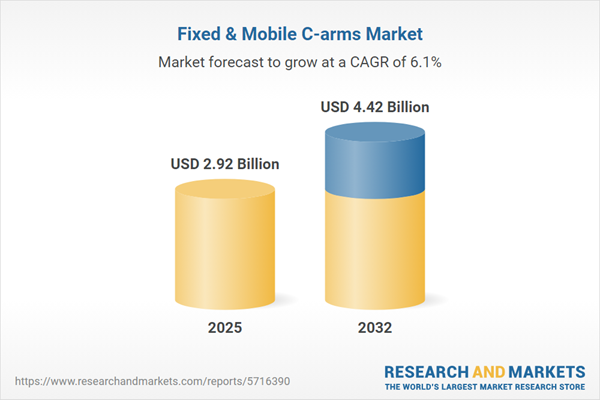Speak directly to the analyst to clarify any post sales queries you may have.
The fixed and mobile C-arms market is transforming surgical imaging across global healthcare, driven by digital intelligence, supply chain innovation, and regional demand for both advanced and accessible solutions. This comprehensive analysis empowers senior leaders to navigate evolving clinical standards, regulatory frameworks, and commercial models in the imaging equipment landscape.
Market Snapshot: Fixed & Mobile C-arms
The Fixed & Mobile C-arms Market grew from USD 2.75 billion in 2024 to USD 2.92 billion in 2025. It is expected to continue growing at a CAGR of 6.09%, reaching USD 4.42 billion by 2032.
This market reflects strong global adoption of fixed and mobile C-arm imaging systems, underpinned by expanding applications in minimally invasive and complex surgical procedures. Market growth is supported not only by technological innovation but also by shifting clinical practices, regulatory environments, and reimbursement policies across key regions.
Scope & Segmentation
Spanning a diverse array of clinical settings and healthcare environments, this market encompasses broad end-user and technology segments. Market segmentation covers:
- Application: Cardiovascular Surgery (including Interventional Cardiology and Vascular Surgery), Dental Surgery, Gastroenterology, Neurosurgery, Orthopedic Surgery (Joint Reconstruction, Spinal Surgery, Trauma Surgery), and Urology.
- End User: Ambulatory Surgical Centers, Clinics, Hospitals (distinguished as Private and Public Hospitals).
- Mobility: Fixed configurations tailored for high-throughput hospital environments and Mobile solutions designed for procedure flexibility in varied clinical spaces.
- Sales Channel: Direct Sales, Distributor Channel, E-Commerce, Value Added Resellers.
- Region: Americas (United States, Canada, Mexico, Brazil, Argentina, Chile, Colombia, Peru, Latin America), EMEA (United Kingdom, Germany, France, Russia, Italy, Spain, Netherlands, Sweden, Poland, Switzerland, United Arab Emirates, Saudi Arabia, Qatar, Turkey, Israel, South Africa, Nigeria, Egypt, Kenya), and Asia-Pacific (China, India, Japan, Australia, South Korea, Indonesia, Thailand, Malaysia, Singapore, Taiwan).
- Key Companies: GE Healthcare Technologies, Siemens Healthineers, Koninklijke Philips, Canon Medical Systems, Shimadzu, Ziehm Imaging, Hologic, OrthoScan, Mindray Medical International, Brivo Medical, among others.
Key Takeaways
- Modern C-arm solutions are now integral for minimally invasive and complex surgical procedures, delivering precise imaging that enhances clinical outcomes and operational efficiency.
- Adoption is driven by innovations in detector technology, AI-powered imaging, modular design, and seamless integration with surgical robotics and navigation systems.
- Healthcare providers value equipment that reduces patient trauma, accelerates recovery, and supports shorter hospital stays.
- Service-oriented ecosystems, including cloud-based imaging, remote maintenance, and analytics, are redefining post-procedural workflows and optimizing total cost of ownership.
- Regional trends highlight growing demand for high-end imaging in developed markets and increasing access to cost-effective mobile platforms within emerging healthcare systems.
- C-arm manufacturers gain competitive advantage by tailoring product portfolios and support models to match unique clinical, regulatory, and resource constraints in diverse markets.
New Tariff Impacts & Supply Chain Adjustments
The introduction of new imaging equipment tariffs in 2025 has directly influenced C-arm sourcing and pricing strategies. Leading vendors are accelerating localization, seeking alternative suppliers, and streamlining logistics to manage cost structures. Distributors are adapting with improved customs expertise and faster delivery timelines, while innovative financing solutions help healthcare providers mitigate near-term price volatility. Stakeholders with agile supply chain responses are well-positioned in this evolving market environment.
Methodology & Data Sources
This report employs a mixed-methods research approach. Primary data was gathered from expert interviews with clinicians, biomedical engineers, and procurement executives. These insights were enhanced by validated secondary data from journals, regulatory resources, and industry white papers. Quantitative synthesis includes equipment shipments, patent records, and macroeconomic trends.
Why This Report Matters
- Provides actionable intelligence for strategic investment in advanced imaging and service-oriented C-arm ecosystems within complex healthcare environments.
- Enables supply chain teams, procurement leaders, and technology executives to benchmark against regional and global adoption trends and regulatory considerations.
- Supports informed decision-making by outlining emerging technology use, evolving sales models, and the interplay between clinical need and economic reality.
Conclusion
The fixed and mobile C-arms market is evolving in response to clinical, technological, and trade-driven pressures. Forward-looking strategies, emphasizing innovation and agile operations, will help stakeholders achieve long-term value and meet changing healthcare demands worldwide.
Additional Product Information:
- Purchase of this report includes 1 year online access with quarterly updates.
- This report can be updated on request. Please contact our Customer Experience team using the Ask a Question widget on our website.
Table of Contents
3. Executive Summary
4. Market Overview
7. Cumulative Impact of Artificial Intelligence 2025
Companies Mentioned
The companies profiled in this Fixed & Mobile C-arms market report include:- GE Healthcare Technologies, Inc.
- Siemens Healthineers AG
- Koninklijke Philips N.V.
- Canon Medical Systems Corporation
- Shimadzu Corporation
- Ziehm Imaging GmbH
- Hologic, Inc.
- OrthoScan Inc.
- Mindray Medical International Limited
- Brivo Medical, Inc.
Table Information
| Report Attribute | Details |
|---|---|
| No. of Pages | 196 |
| Published | October 2025 |
| Forecast Period | 2025 - 2032 |
| Estimated Market Value ( USD | $ 2.92 Billion |
| Forecasted Market Value ( USD | $ 4.42 Billion |
| Compound Annual Growth Rate | 6.0% |
| Regions Covered | Global |
| No. of Companies Mentioned | 11 |









